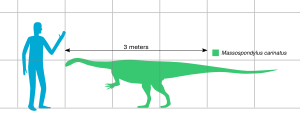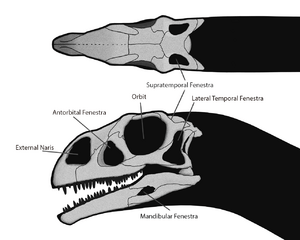Massospondylus facts for kids
Quick facts for kids MassospondylusTemporal range: Upper Triassic to Lower Jurassic
|
|
|---|---|
 |
|
| Massospondylus | |
| Scientific classification | |
| Kingdom: | |
| Class: | |
| Superorder: | |
| Order: | |
| Suborder: | |
| Infraorder: | |
| Family: | |
| Genus: |
Massospondylus
Owen, 1854
|
Massospondylus was a type of dinosaur that lived a very long time ago, from the Upper Triassic to the Lower Jurassic periods. This means it lived about 200 million years ago!
For a long time, people thought Massospondylus walked on all four legs. But a study in 2007 showed it actually walked on two legs, like a bird. It probably ate plants (herbivore), but some scientists think early sauropodomorphs might have eaten both plants and meat (omnivorous). This dinosaur was about 4–6 metres (13–20 ft) long. It had a long neck and tail, a small head, and a thin body. On each of its front feet, it had a sharp thumb claw. This claw was likely used for defense or to help it eat. Recent studies suggest that Massospondylus grew steadily throughout its life. It also had air sacs similar to birds, and it might have even taken care of its babies.
Discovering Massospondylus
Massospondylus was a medium-sized dinosaur. It was usually around 4 metres (13 ft) long and weighed about 1000 kilograms (2200 lb). Some scientists think it could grow up to 6 metres (20 ft) long. It looked like many other early sauropodomorphs. It had a slender body, a long neck, and a head that was very small compared to its body.
Its backbone had nine neck bones, 13 back bones, three hip bones, and at least 40 tail bones. Its hip bone, called the pubis, pointed forward, which is common for saurischian dinosaurs. Massospondylus was built a bit lighter than Plateosaurus, another similar dinosaur. Its neck was longer than most other plateosaurids. The front neck bones were four times longer than they were wide.
The front legs of Massospondylus were only half as long as its back legs. But they were quite strong! This is shown by the wide upper part of its arm bone (humerus), which had lots of space for strong arm muscles. Like Plateosaurus, it had five fingers on each hand and five toes on each foot. Its hand was short and wide, with a large, curved thumb claw. This claw was probably used for getting food or protecting itself from predators. The thumb was the longest finger, while the fourth and fifth fingers were tiny. This made its front paws look a bit uneven.
What Did Its Head Look Like?

The small head of Massospondylus was about half the length of its thigh bone. Its skull had many openings, called fenestrae. These holes made the skull lighter and provided space for muscles and sense organs. There were pairs of these openings, one on each side of the skull.
At the front of the skull, there were two large, oval-shaped nares (nostril openings). These were about half the size of its eye sockets. The eye sockets were bigger in Massospondylus than in similar dinosaurs like Plateosaurus. There were also smaller openings called antorbital fenestrae between the eyes and the nose. At the back of the skull, there were two more pairs of openings: the lateral temporal fenestrae right behind the eye sockets, which looked like an upside-down "T" in Massospondylus, and the supratemporal fenestrae on top of the skull. Even its lower jaw had small openings.
The skull is usually shown as wider and shorter than Plateosaurus's skull. However, this might be because of how the fossil skulls were squashed over millions of years. Some parts of the skull could be different between individual dinosaurs. For example, the thickness of the bone above the eye and the height of the back part of the upper jaw bone (maxilla) could vary. These differences might be because of sexual dimorphism (differences between males and females) or just natural variation between individuals.
The number of teeth in Massospondylus could change, and it increased as the skull grew bigger. The front part of the upper jaw (premaxilla) always had four teeth on each side. But in the main upper jaw (maxilla), the number of teeth ranged from 14 to 22. The largest known skull had 26 teeth on each side of the lower jaw. The teeth at the front of the upper jaw were shorter than those at the back. However, in the lower jaw, the teeth were mostly the same height. The teeth didn't show much wear, and their different heights suggest that new teeth replaced old ones quite quickly.
Interestingly, the teeth looked different depending on where they were in the jaw. This is called heterodonty. It was more noticeable in Massospondylus than in Plateosaurus, but not as extreme as in Heterodontosaurus. Teeth closer to the front of the snout were round and pointy. But the back teeth were shaped like spatulas and had oval cross-sections.
Like other early sauropodomorphs, it's thought that Massospondylus had cheeks. This idea comes from the few large holes for blood vessels on its jaw bones, unlike the many small holes seen in reptiles without cheeks. Cheeks would have helped keep food inside its mouth while it ate. Some older studies suggested Massospondylus had a big overbite and a hard, beak-like tip on its lower jaw. However, newer studies think the overbite might just be from squashed fossils, and a beak is unlikely.
Images for kids
-
Skull of the neotype specimen (BP/1/4934) of M. carinatus
-
Mounted Massospondylus skeleton cast at the Natural History Museum, London, showing an outdated quadrupedal pose
See also
 In Spanish: Massospondylus para niños
In Spanish: Massospondylus para niños











